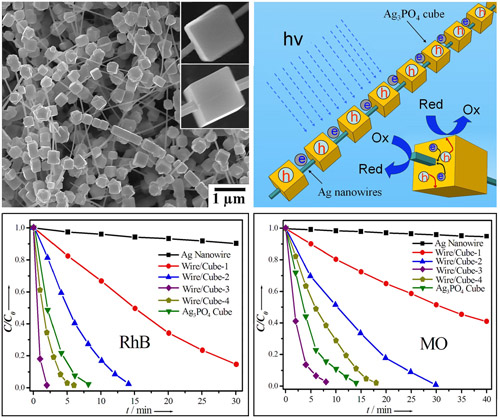Metal/semiconductor heterogeneous photocatalytic materials have been a hot topic in photocatalytic field. However, due to their structural and functional defects, the reported heterogeneous materials have certain shortcomings, such as low photon-generated carrier separation efficiency and poor visible light-driven catalytic property. Therefore, the design and preparation of metal/semiconductor heterogeneous visible light driven photocatalysts with highly efficient electron-hole pairs separation and rapid electron transfer have been a problem to be urgently solved.
The energy and nano-catalytic materials for environment research group at Lanzhou Institute of Chemical Physics (LICP), Chinese Academy of Sciences (CAS), has fabricated a new heterogeneous photocatalyst, namely Ag nanowire/Ag3PO4 cube necklace-like heterostructures, by a facile and efficient process. They have prepared Ag3PO4 cube necklace-like heterostructures via selective growth of Ag3PO4 submicro-cubes on Ag nanowires. The size, morphology, position and number of the Ag3PO4 cube of the necklace-like heterostructures can all be controlled.
 |
| SEM image, photo-generated carrier separation mechanism and photo catalytic property of Ag nanowire/Ag3PO4cube necklace-like heterostructures. |
A detailed study of the photocatalytic activity of the heterostructures shows that Ag nanocrystals possess a favorable Fermi level and can serve as a good electron acceptor for facilitating quick electron transfer from both exterior and inner Ag3PO4 cubes under visible-light irradiation. Thereby, the photoexcited electrons can be rapidly transferred to Ag nanowires and the photoinduced holes can still locate on Ag3PO4 cubes, which promote the effective separation of photoexcited electron–hole pairs and decrease the probability of electron–hole recombination. More importantly, the enriched electrons on the Ag nanowires could be effectively exported due to the novel necklace heterostructure, which facilitates their participation in the multiple-electron reduction reaction of oxygen (O2+2H++ 2e-→H2O2).
Their photocatalytic performance studies indicate that these novel heterostructures exhibited much higher catalytic activities than pure Ag3PO4 cubes or Ag nanowires for the degradation of organic dyes under visible-light irradiation. These demonstrations reveal that the rational design and fabrication of necklace-like metal–semiconductor heterostructures may be an effective technique to improve photocatalytic activity, and will most probably be applicable in the development of the generation of highly efficient visible-light sensitive photocatalysts.
The work has received support from the National Natural Science Foundation of China . The findings have been published in J. Mater. Chem.(J. Mater. Chem., 2012, 22, 14847-14850)and Chemistry--A European Journal (Chem. Eur. J. 2012, DOI: 10.1002/ chem.201201435,under publication).


